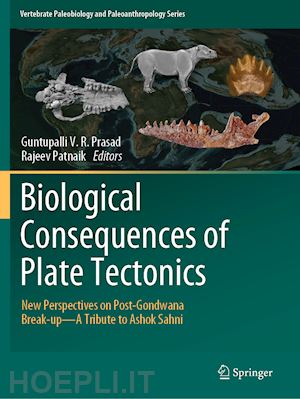
Questo prodotto usufruisce delle SPEDIZIONI GRATIS
selezionando l'opzione Corriere Veloce in fase di ordine.
Pagabile anche con Carta della cultura giovani e del merito, 18App Bonus Cultura e Carta del Docente
Dr. Guntupalli V.R. Prasad received his Ph.D. from Panjab University, Chandigarh in the year 1986. He is a former Professor at the University of Jammu and Indian Institute of Science Education & Research (Kolkata). He is presently a Professor in the Department of Geology, University of Delhi, India. Prof. Prasad has more than 34 years teaching experience at Graduate and undergraduate level. A vertebrate paleontologist by training, he has been working for the last three and half decades on the evolution of Mesozoic vertebrates of India using form and function of vertebrate fossils. Prasad’s research has focused primarily on biodiversity changes during the time span of Deccan volcanism which brought many new species of fishes, amphibians, reptiles and mammals to light and also provided paleontological constraints on the age of initiation and duration of Deccan Volcanism. His research has also thrown light on faunal dispersals and biogeographic linkages between the physically isolated and rapidly northward drifting Indian plate and other landmasses. Dr. Prasad’s findings of diverse mammalian groups from the Jurassic and Cretaceous of India have firmly placed India on Mesozoic mammalian map of the world. Author of more than 100 scientific papers published in leading journals in his field of specialization as well as high impact journals like Nature, Science, Nature Communications, and Proceedings of National Academy of Sciences, Prof. Prasad received Shanti Swarup Bhatnagar Prize, India’s highest science award, for his outstanding contributions in the field Vertebrate Paleontology. Other recognitions received by Prof. Prasad include J.C.Bose National Fellowship, National Geoscience Award, L. Rama Rao Birth Centenary Award, and National Award in Geosciences & Technology. He has been honored with the Fellowship of the Indian National Science Academy (FNA), Indian Academy of Sciences (FASc.), National Academy of Sciences (FNASc.), and Academy of Sciences for the Developing World (TWAS).











Il sito utilizza cookie ed altri strumenti di tracciamento che raccolgono informazioni dal dispositivo dell’utente. Oltre ai cookie tecnici ed analitici aggregati, strettamente necessari per il funzionamento di questo sito web, previo consenso dell’utente possono essere installati cookie di profilazione e marketing e cookie dei social media. Cliccando su “Accetto tutti i cookie” saranno attivate tutte le categorie di cookie. Per accettare solo deterninate categorie di cookie, cliccare invece su “Impostazioni cookie”. Chiudendo il banner o continuando a navigare saranno installati solo cookie tecnici. Per maggiori dettagli, consultare la Cookie Policy.